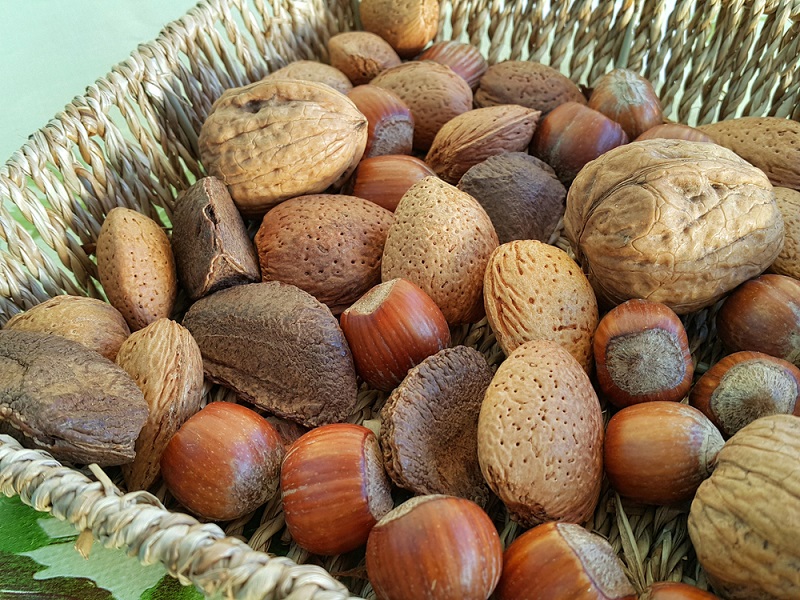
Small, crunchy and inconspicuous – yet full of fat, which can be healthier than olive oil. Nuts are now on the lists of so-called superfoods for a reason. They contain mono- and polyunsaturated fatty acids, fiber, minerals, B vitamins and even natural antioxidants. What's more, each type has its own unique profile: taste, consistency, nutritional value and use. But let's start with the basics, i.e. what are the types of nuts?
Different types of nuts
What used to be an addition to cakes or an element of the holiday table, is now increasingly present in everyday cuisine. Nuts – although seemingly fatty – are not enemies of the diet. Quite the opposite. These are some of the most nutritionally dense products that can be included in your diet without complicated planning. A small portion a day - literally a few pieces - is enough to really affect the quality of your nutrition.
Walnuts are worth adding to oatmeal, especially those from chemical-free crops – such as gluten-free Pięć Przemian walnuts, whose distinctive flavor goes perfectly with apple and cinnamon. In addition, BIO Planet hazelnuts – ideal for homemade granola or as a snack between meals. They have a slightly sweet profile that even children will like.
Are you looking for something creamier? Cashews are a choice that does not disappoint. The classic version – Bio Planet cashews – work great as a base for vegan sauces or plant-based cheeses. There are also nuts that are worth eating because of their unique properties. Brazilian nuts are the best natural source of selenium – a mineral that is rarely found in other products. Choose BIO NaturaVena Brazil nuts if you care about the highest quality of origin and the lack of artificial additives.
Also worth mentioning are the lesser-known gems – BIO Bio Planet pecan nuts with a mild, buttery taste, which are great in home baking, and macadamia nuts, creamy and subtly fatty, often chosen by people on a ketogenic diet. BIO Bio Planet macadamia nuts are particularly recommended, which, thanks to their high content of monounsaturated fats, fit perfectly into a diet supporting heart health.
Nuts don't have to be just an addition to a Christmas cake. They can become an everyday element of your diet – from morning oatmeal, through salads, to healthy desserts and bread spreads. You just need to know which ones to reach for and how to combine them with what you already eat.
Check also: How much dried fruits to eat in a day and which ones are good for your health?
Different kind of nuts – main differences
Each type of nut has its own characteristic set of nutritional properties. Walnuts are rich in omega-3 fatty acids, hazelnuts are high in vitamin E and folic acid, and Brazil nuts are one of the best sources of selenium. Cashews are delicate and creamy, making them perfect for plant-based cuisine. Macadamia nuts, on the other hand, are high in monounsaturated fatty acids.
All types of nuts – which ones are worth choosing?
Choosing the best type of nut depends on your individual needs. Walnuts are recommended for supporting the nervous system, cashews for skin and nails, and macadamia for the heart. Children will happily reach for delicate hazelnuts, and people on a low-carb diet will appreciate Brazilian and pecan nuts.
Types of nuts – list
• Walnuts
• Hazelnuts
• Cashews
• Brazil Nuts
• Pecan Nuts
• Macadamia Nuts
• Pine Nuts
• Peanuts (although botanically not tree nuts)
Each of these products has its own uses in cooking and diet. They can be a base for spreads, an addition to oatmeal, an ingredient in desserts or a healthy snack in themselves.
Different kind of tree nuts
Tree nuts are those that naturally grow on trees – unlike peanuts, which are legumes. This group includes walnuts, hazelnuts, pecans, macadamia nuts, Brazil nuts and cashews. They are usually rich in fats, minerals and fat-soluble vitamins, making them an extremely nutritious part of a healthy diet. Each nut has its own unique character and value, so it is worth rotating them in your diet to take full advantage of their diversity.
The impact of nuts on the body – what is worth eating and when?
The brain – walnuts and pecans
Thanks to the high content of omega-3 fatty acids and antioxidants, walnuts and pecans support the nervous system, concentration and memory. Their regular consumption has a beneficial effect on neurotransmitters and reduces the risk of dementia.
The heart and vessels – macadamia and hazelnuts
Macadamia nuts, rich in monounsaturated fats, help maintain a good lipid profile. Hazelnuts, known for their high vitamin E and potassium content, have a similar effect.
Thyroid and immunity – Brazil nuts
Selenium present in Brazil nuts is an element important for thyroid function, metabolism and immunity. Selenium deficiencies can lead to Hashimoto's and hormonal problems.
Skin, hair and nails – cashews and hazelnuts
The zinc, selenium, copper and vitamin E content in cashews and hazelnuts supports skin elasticity, hair growth and cell regeneration.
What types of nuts are there? Summary
Nuts are not just a snack – they are a source of fats, protein and vitamins.
• Choosing the right type of nut depends on your health goals.
• Walnuts and pecans support the brain, Brazil nuts – the thyroid.
• Cashews are versatile – for cooking, creams and snacks.
• Certified versions of nuts are a guarantee of quality and safety.



